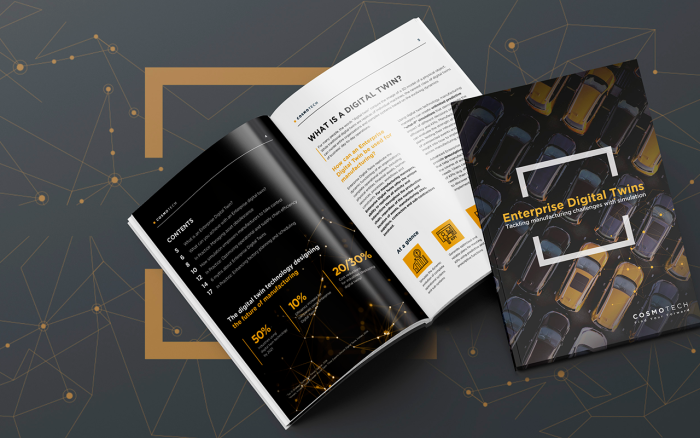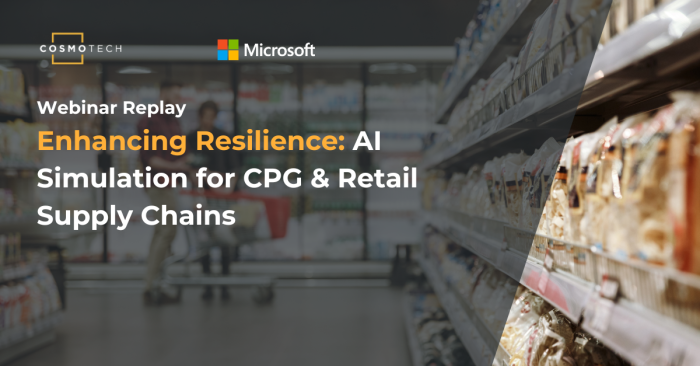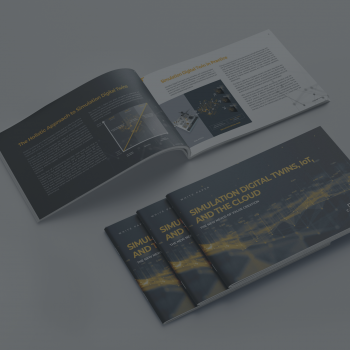In the first article in this series, supply chain resilience was defined as the combination of resistance and recovery building the capacity of the system to resist and react efficiently to a disruption. In this article, we outline the different types of disruptions and explain how Cosmo Tech’s Simulation Digital Twins help clients improve their supply chain resilience.
There’s no limit to what might disrupt a modern, global supply chain.
Today’s global supply chains stretch not only across countries but around the world. Risks and disruptions range from local transport delays and inclement weather through price fluctuations and labor strikes, and onto natural disasters, political upheaval and, yes, pandemic disease lockdowns.
Anticipating these uncertainties and implementing effective supply chain risk management is a key task of every supply chain manager. Increasingly, these supply chain managers are turning to new technologies such as digital twin simulation to help them prepare and plan for disruptions and adopt optimal supply chain strategies to resist and react to these challenges.
Two Types of Supply Chain Disruptions
While there are any number of incidents that might disrupt a supply chain, they can be divided into two broad types: risks and uncertainties.
Risks are disruptions that – while unwanted – are not unpredictable. They emerge somewhat regularly and past experience with these risks help inform the mitigation strategies and supply chain resilience programs that are adopted to address them.
Risks can be measured in terms of how often they occur and their impact on the supply chain when they do.
A machine breakdown, for example, is relatively common, particularly in a global supply chain with dozens or even hundreds of plants. The impact of a single machine on that global supply chain, though, is usually limited, and the risk to the effective functioning of the chain equally limited.
A labor strike, on the other hand, is likely to occur far less often than a machine breakdown. Yet the impact of a strike on the supply chain is likely to be far more important. A six-week strike by GM autoworkers in 2019, for example, saw ripple effects across the automotive supply chain. Some 75,000 automotive parts employees were laid-off or had their wages reduced, more than 100 different suppliers cut their workforce, and even associated industries such as steel mills saw demand drop significantly.
Uncertainties, on the other hand, are unpredictable events. These disruptions have either not been previously encountered or, if not new, have an impact that falls outside of all past experience. Unlike risks, the impacts of uncertainties fall outside of the combined experience of the supply chain resilience team.
An event such as the 2011 tsunami and Fukushima nuclear accident is a good example of an uncertainty impacting supply chains in Japan and East Asia specifically, and the global economy more generally. It was not as if earthquake activity was unexpected in Japan – the island nation had experienced a major earthquake more than a dozen times in the first decade of the 21st century. Tsunamis, too, are an obvious and regular run-on effect of an earthquake. Nuclear accidents, while rarer, are not unknown and the nuclear industry is heavily regulated to maintain a safe environment.
Yet in 2011 the risk of an earthquake, the risk of a tsunami, and the impact of both on a nuclear power plant created what President of the Federation of American Scientists Charles Ferguson described as a perfect storm:
We had the most massive recorded earthquake in the 140 years of Japan recording earthquakes. It was beyond design basis for that region and for that nuclear power plant. Then, this huge wave of water came in and, roughly an hour after the initial shock of the quake, hit the area of the nuclear power plant, knocked out external power, and knocked out the emergency diesel generators onsite at the plant.
While earthquakes, tsunamis, and nuclear accidents were all considered risks, the combination of the three and its out-of-all-experience impact on Japan made it truly unpredictable in scope. Japanese auto production dropped nearly 50% and had cascading effects on production in other countries including Indonesia (down 6%), Thailand (down 19%), and the Philippines (down 24%).
In the quest for supply chain resilience, then, both risks and uncertainties need to be considered – but how can supply chain strategies be adopted in the face of disruptions that cannot always be anticipated?
Simulation Digital Twins and Supply Chain Resilience
Supply chain strategies focused on risk management demands an investment in resistance, while those same strategies focused on uncertainty demands an investment in recovery. Overall supply chain resilience is improved by addressing both resistance to risk and recovery from uncertainty.
Cosmo Tech’ Simulation Digital Twins are an innovative technology that enable supply chain managers to anticipate risks to their system and plan for recovery from the inevitable but unpredictable uncertainties via four core software features.
Users can complete a risk impact assessment that allow them to understand the quantified impact of risks on corporate KPIs. By setting variables for supply, demand, and lead times and then launching simulations to explore the dynamic interactions and impacts that emerge, users can head-off problems before they emerge and avoid the devastating cascading effects common in complex supply chains.
Preparing for uncertainties is possible by dramatically modifying the data for specific resources, parameters, and elements of the supply chain, then running simulations to determine its impact. Simulating the impact of a supplier shutdown, a transport lockdown, or a critical drop in demand is simple, and preparing optimal response strategies is straightforward.
Cosmo Tech also helps to identify the most critical points in a supply chain via automated sensitivity analysis. Once you understand the most influential links in a supply chain and reinforce those links, your overall supply chain resilience is improved.
Finally, Cosmo Tech’s software offers robustness optimization that delivers optimal and resistant supply chain strategies including details of all the relevant decisions at every timestep. Stock levels, for example, can be a lever that improves robustness of the overall system even if there is a short-term hit to cash on hand. By configuring objectives and launching a robustness optimization that employs stochastic simulation, users can identify such levers and develop their best supply chain resistance strategy.
Supply Chain Resilience: Prepare, Augment, Optimize
It’s impossible to predict the impact of every disruption and economically unfeasible to assure resistance to every uncertainty.
However, by employing innovative modeling and simulation technologies such as Cosmo Tech’s Simulation Digital Twins, supply chain managers can better prepare for disruptions whether they be foreseeable risks or unpredictable uncertainties. In the wake of the COVID-19 pandemic and the supply chain disruptions that came with it, there has never been a more important time to adopt the right strategies to improve supply chain resilience.
In the next article in this series we’ll explain six ways that resilience can be improved through supply chain management optimization.





![[Video] Traditional vs Resilient Supply Chain Planning: Which side are you on?](jpg/adobestock_101964830-350x350.jpg)

